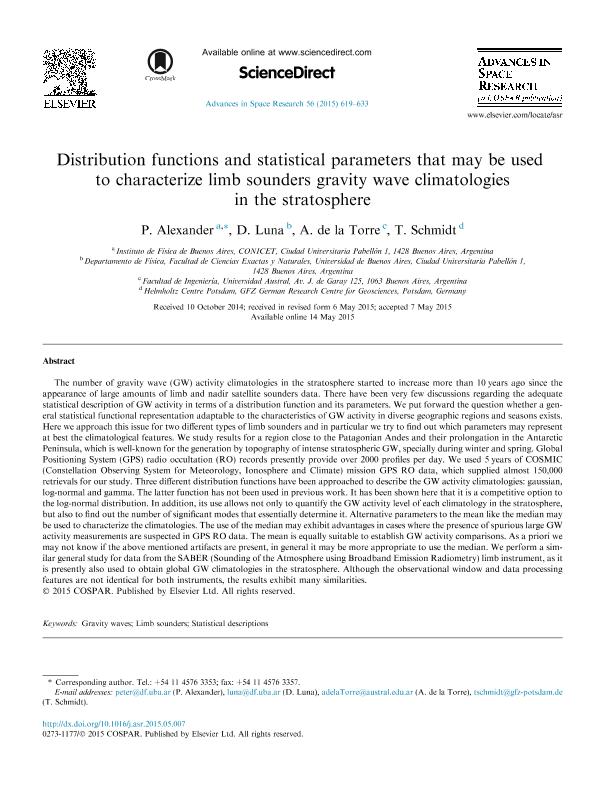Mostrar el registro sencillo del ítem
dc.contributor.author
Alexander, Pedro Manfredo

dc.contributor.author
Luna, D.
dc.contributor.author
de la Torre, Alejandro

dc.contributor.author
Schmidt, T.
dc.date.available
2018-03-09T15:37:26Z
dc.date.issued
2015-08
dc.identifier.citation
Alexander, Pedro Manfredo; Luna, D.; de la Torre, Alejandro; Schmidt, T.; Distribution functions and statistical parameters that may be used to characterize limb sounders gravity wave climatologies in the stratosphere; Elsevier; Advances in Space Research; 56; 4; 8-2015; 619-633
dc.identifier.issn
0273-1177
dc.identifier.uri
http://hdl.handle.net/11336/38395
dc.description.abstract
The number of gravity wave (GW) activity climatologies in the stratosphere started to increase more than 10 years ago since the appearance of large amounts of limb and nadir satellite sounders data. There have been very few discussions regarding the adequate statistical description of GW activity in terms of a distribution function and its parameters. We put forward the question whether a general statistical functional representation adaptable to the characteristics of GW activity in diverse geographic regions and seasons exists. Here we approach this issue for two different types of limb sounders and in particular we try to find out which parameters may represent at best the climatological features. We study results for a region close to the Patagonian Andes and their prolongation in the Antarctic Peninsula, which is well-known for the generation by topography of intense stratospheric GW, specially during winter and spring. Global Positioning System (GPS) radio occultation (RO) records presently provide over 2000 profiles per day. We used 5 years of COSMIC (Constellation Observing System for Meteorology, Ionosphere and Climate) mission GPS RO data, which supplied almost 150,000 retrievals for our study. Three different distribution functions have been approached to describe the GW activity climatologies: gaussian, log-normal and gamma. The latter function has not been used in previous work. It has been shown here that it is a competitive option to the log-normal distribution. In addition, its use allows not only to quantify the GW activity level of each climatology in the stratosphere, but also to find out the number of significant modes that essentially determine it. Alternative parameters to the mean like the median may be used to characterize the climatologies. The use of the median may exhibit advantages in cases where the presence of spurious large GW activity measurements are suspected in GPS RO data. The mean is equally suitable to establish GW activity comparisons. As a priori we may not know if the above mentioned artifacts are present, in general it may be more appropriate to use the median. We perform a similar general study for data from the SABER (Sounding of the Atmosphere using Broadband Emission Radiometry) limb instrument, as it is presently also used to obtain global GW climatologies in the stratosphere. Although the observational window and data processing features are not identical for both instruments, the results exhibit many similarities.
dc.format
application/pdf
dc.language.iso
eng
dc.publisher
Elsevier

dc.rights
info:eu-repo/semantics/openAccess
dc.rights.uri
https://creativecommons.org/licenses/by-nc-sa/2.5/ar/
dc.subject
Gravity Waves
dc.subject
Limb Sounders
dc.subject
Statistical Descriptions
dc.subject.classification
Meteorología y Ciencias Atmosféricas

dc.subject.classification
Ciencias de la Tierra y relacionadas con el Medio Ambiente

dc.subject.classification
CIENCIAS NATURALES Y EXACTAS

dc.title
Distribution functions and statistical parameters that may be used to characterize limb sounders gravity wave climatologies in the stratosphere
dc.type
info:eu-repo/semantics/article
dc.type
info:ar-repo/semantics/artículo
dc.type
info:eu-repo/semantics/publishedVersion
dc.date.updated
2018-03-09T14:43:59Z
dc.journal.volume
56
dc.journal.number
4
dc.journal.pagination
619-633
dc.journal.pais
Países Bajos

dc.journal.ciudad
Amsterdam
dc.description.fil
Fil: Alexander, Pedro Manfredo. Consejo Nacional de Investigaciones Científicas y Técnicas. Oficina de Coordinación Administrativa Ciudad Universitaria. Instituto de Física de Buenos Aires. Universidad de Buenos Aires. Facultad de Ciencias Exactas y Naturales. Instituto de Física de Buenos Aires; Argentina
dc.description.fil
Fil: Luna, D.. Universidad de Buenos Aires. Facultad de Ciencias Exactas y Naturales. Departamento de Física; Argentina
dc.description.fil
Fil: de la Torre, Alejandro. Universidad Austral. Facultad de Ingeniería; Argentina
dc.description.fil
Fil: Schmidt, T.. Helmholtz Centre Potsdam; Alemania
dc.journal.title
Advances in Space Research

dc.relation.alternativeid
info:eu-repo/semantics/altIdentifier/doi/http://dx.doi.org/10.1016/j.asr.2015.05.007
dc.relation.alternativeid
info:eu-repo/semantics/altIdentifier/url/https://www.sciencedirect.com/science/article/pii/S0273117715003324
Archivos asociados
